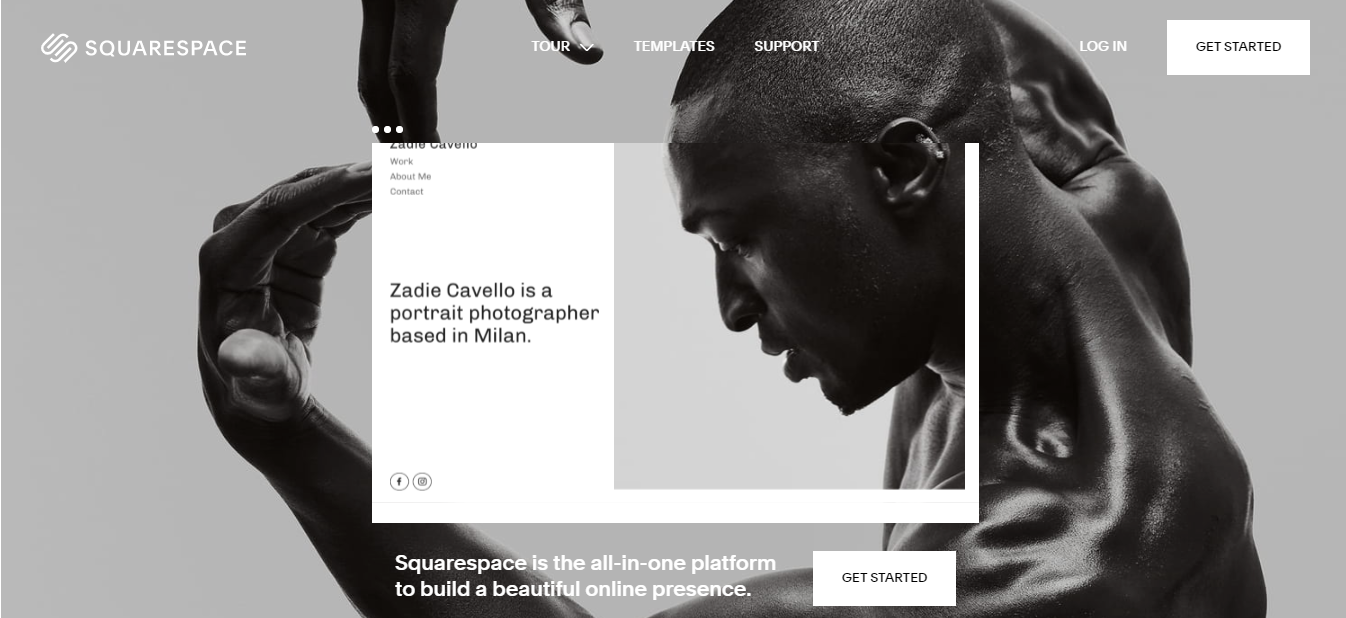

Quick Links
Quick Links

Digital freelance portfolios are amazing tools that help freelancers stand out from the crowd. Even if you feel you’re one of the best at what you do, nobody will know it unless you have real evidence you can share with potential clients.
Many entrepreneurs and freelancers find it challenging to navigate through a crowded industry. It can be difficult trying to get the right clients while also marketing a product or service. When trying to attract new clients, highlight skills, strengthen brands, and become more visible online all at the same time, impressive digital freelance portfolios that showcases successes will help to accomplish these goals.
When freelancers need to prove themselves professionally, it’s crucial to show, rather than just tell. Research shows that 90% of the information our brain processes is visual and that people who use visual content are 43% more likely to persuade their given audience (think potential clients).
Freelancers must take time to objectively review current freelance portfolios.
Think: As a client, would you be impressed by what is on each page?
Be honest and see where you might be able to modify your portfolio in order to maximize your odds of standing out from the competition and getting paid exactly what you’re worth.
Here are nine steps to take that strengthen digital freelance portfolios, no matter what industry you’re in.
(1) Choose Your Channels

If you’re not a web designer/developer, you’re probably looking for the best pre-designed freelance portfolios that will work for showcasing your skills or product offerings. Look for ready-made website builders that help you create effective, quality portfolios quickly. These sites are also excellent for helping you:
- Showcase your work professionally,
- Increase your visibility,
- Gain industry contacts, and
- Create new business opportunities
Website Builders for Creating and Updating Freelance Portfolios
Wix — Very intuitive, with more than 500 templates. Drag and drop editing is perfect for writers who want to spend time editing their words rather than their portfolio. 110 million plus websites use Wix.
Weebly — Extremely easy to use with clean and basic templates. Excellent for engineers and graphic designers who need clean templates to demonstrate highly visual projects. More than 40 million websites use Weebly.
For a more in-depth comparison between Wix and Weebly, refer to this guide.
Squarespace — Has stunning templates that create mobile-responsive websites for all fields. Works well for project managers, virtual assistants and others in logistical roles to showcase flow charts and brainstorming sessions with attractive images. Over 1 million websites use Squarespace.

And, when it comes to promoting talent, experience, and skills even further, it goes without saying that social media is extremely beneficial. It’s often said that Instagram and YouTube work side by side with freelance portfolios. Depending on your field of expertise, this can be a little true or spot on.
Placing social media icons on freelance portfolios is an easy way to connect with prospective clients and customers. Many potential clients are interested in seeing freelancers’ comprehensive web presence before they decide whether they want to work with them. They’d like to see how freelancers promote themselves and engage with others via social media.
Creating professional social media accounts that highlight talent, experience, hard skills, and soft skills can be a game-changer.
(2) Keep Freelance Portfolios Error-Free
Digital portfolios need to present an air of authority. Your digital portfolio is the evidence you use to show that you are credible in your field and capable of providing a high-quality product or service, free of mistakes. This is why you want to make sure you have proofed all sections of your portfolio before you hit publish.
Potential clients might be reluctant to hire people whose freelance portfolios show errors — it puts your credibility in question and is unlikely to inspire trust. Even if what you’re offering has nothing to do with writing, for instance, misspelled words and poor grammar in freelance portfolios leave a bad first impression. This is a quick way for potential clients to weed you out from the competition before you’ve even had a chance to talk.
Make sure you have someone else read over your bio and look through your visual content after you proof it to ensure that all the elements are as polished as possible.
(3) Have a Professional Photo

Providing a photo on your digital portfolio puts a face to your name and experience. It also helps prospective clients and customers “connect” with you. This is very important since you are unlikely to meet in person.
Providing a professional photo does not necessarily mean you need to hire a professional photographer, although that can definitely be advantageous. “Professional,” in this case means that the photo you choose should be high quality. It should be a clear headshot of you in corporate attire in an appropriate pose and setting.
A high-quality photo sends the message that you pay attention to detail, respect clients, and value yourself and your work.
(4) Upload Client Reviews
Recommendations and testimonials from past clients can greatly boost your credibility. They are also helpful if you’re just starting out and are working to add more samples to your digital portfolio. Having references already included makes you look proactive and professional. Potential clients are able to see that you are well prepared and that your work and experience are respected.
Don’t hesitate to ask for reviews from clients who are happy with your work. If you know that you gave it your best, you should have the confidence to ask for this social proof that you can publish on your freelance portfolio.
(5) Include Education and Work Experience

Your education and experience tell a story about your background and work history. It can be extremely beneficial to have a few work samples from a variety of areas or industries. It shows that you are adaptable and highly skilled. However, it can also be good to narrow it all down to a single area of focus. And always focus on the results that you get for clients.
Including your education shows that you undertook proper schooling or training for the services you are offering and that you have developed skills in an accredited manner. Including your educational experience is also helpful because it can be a talking point with potential clients and customers. It could be seen as an asset, especially if you studied at a highly respected institution, but also because it might be a place of common ground between you and the client.
With regard to your past work experience, focus on what shows your ideal clients how you have applied the knowledge you acquired. It can be tempting to use your digital portfolio as a space to “dump” all of your previous work, but you should instead be deliberate about what you include. Just as you would tailor your resume or a discussion about your past experience — not listing every single past work experience — you should carefully curate the pieces within your portfolio. Use the experience that is relevant to the current work you desire and that exemplifies related education, as well as any that highlights other traits that are valuable to that work.
(6) Create Expert Content

Guest posting is one of the most beneficial ways to create your own content within your expertise. Look for blogs or online publications that accept submissions from freelancers. Guest posting helps you get attention and gain exposure, allowing you to be seen as an authority in your field. The same goes for guesting on podcast episodes, although this will come after you have gained some traction.
Publishing content on your own blog, YouTube channel, podcast, etc. is also highly recommended. In addition to the above benefits, a blog can boost search rankings for your freelance portfolio. It also allows you to offer guest post exchanges, which boost visibility even more. Video and audio content is much easier to consume, boosting the chances that your audience will pay attention.
Quality content will help you gain respect, and in time, clients will start coming to you through those channels, wanting you to implement the strategies you suggested in your articles, videos, podcast episodes, etc.
(7) Build Connections

Relationships run the world, and in this world of social media, relationships have taken on a whole new approach. Online social networks help to foster professional and personal relationships as well as provide the inspiration, encouragement and support needed to grow a successful freelance business. Connecting with others via the various social networks like Facebook, Twitter and Instagram also help to keep you up-to-date on the latest news, trends and relevant content.
As an expert in your field, a post you create could be shared dozens of times, ultimately going viral. Any content that you make, where others repost or share, can be used as a sample of work to be added to your digital portfolio. Highlight the content that has gained a lot of shares. A well-thought out post can pique the interest of potential clients looking to offer high-paying work for someone with your exact skills and expertise.
Perhaps you write a post that a celebrity or Influencer comments on. That is yet another item you can feature in your portfolio as a sample celebrated by someone with major clout. While you may not have an exact relationship with this celebrity or Influencer, a connection was made that works to further build your credibility and appeal to clients. Social media can also be used to build connections with industry experts that can then be leveraged for everyone’s benefit.
Engaging with others on social media is also a surefire way to make connections. Follow those who are in the same or similar niches. Comment on posts, photos and messages with genuine responses. Give feedback and share free advice or guidance as appropriate. Engagement is an excellent way to quickly gain followers and create value and trust.
Guesting, mentioned above, is another way to build connections on other platforms. The fact that another expert allowed you to share information on their site creates a connection with them and their audience. When you continue to guest on popular channels, you’ll notice that clients start coming to you.
(8) Add Case Studies to Freelance Portfolios

If you work as a freelancer or have a business where you create content or a product in a non-visual field like sales or management, you can still create a portfolio to demonstrate your work. It might require a bit more creative thinking, but having a digital portfolio in a field that is logistical will really help you stand out.
Consider creating case studies about past clients you helped. They could be on a marketing strategy you developed or a summary of how you revamped systems and processes using Quickbooks and Excel. Perhaps you set up Google Analytics on a client’s website for complex multi-level tracking or applied deep SEO, doubling their traffic in the span of a few months.
Whatever the specific task was, focus on demonstrating the critical thinking and problem-solving skills that brought value to the client. And get a review to support this as well.
If you decide to use case studies, don’t include all the details, just the highlights. But make sure that you always document the details of your projects. This way, when asked, you can clearly show how you helped each client solve their problem or accomplish their goal. As you structure your case study, make sure you answer these questions:
- What was the client’s business challenge?
- What was the strategy that was applied to address this challenge?
- What was the creative solution that was developed?
- What were the measurable results? What did success look like?
Include these case studies in your digital portfolio, as examples that demonstrate your knowledge and expertise. They do not need to be colorful or highly creative, as good thinking speaks for itself. Moreover, unique and original thinking that helps solve problems can help to showcase you as a thought leader. This can skyrocket your freelance career as you become highly sought after.
Note: You must respect your clients’ confidentiality when you create these case studies. If you think that identifying them or their company in any way is necessary or will make the story special, make sure you ask their permission first.
(9) Clearly Explain Who You Are

Make sure you have a very visible section on your portfolio that clearly explains who you are and what you do. If a prospective client lands on your profile and cannot see who you are and what exactly it is that you do, you might have lost a connection.
Include these essential elements:
About You
Tell your story in a brief, relatable and personable manner. Make sure to choose the pieces of your story that support you as a professional. You might share how you got into the field, why you love the specific tasks, or what drives you to always give your best to clients. Don’t be afraid to let your personality shine through in this section; after all, this part is about you.
What You Do / How You Work
Give your title in this section if it adds to your credibility. Give details about the services you provide and what your work entails. Explain your approach to work, including the methods and strategies you use to provide clients with outstanding work. You don’t need to get so detailed here as to give away your edge; just tell enough to indicate your ability and the value that you bring.
Call to Action
Create a page or section titled, “Hire Me,” “Work with Me,” “Contact Me,” or any other appropriate title that encourages prospective clients to get in touch. Summarize in a couple of sentences all the value that you’ve explained in other sections of your portfolio. Then tell them where they can find you.
Include your email address, phone number (if you feel comfortable), Skype username, and your professional social media profiles – basically any channel where clients can connect with you. Just make sure that you monitor these channels closely so you don’t give a bad impression by not responding promptly.
Next Steps for Awesome Freelance Portfolios
Start reviewing your current online portfolio to see how well it is performing for you. Is it accurately representing your value as a freelancer? If it has been a while since you read over your portfolio, take time to carefully analyze what it really says about you. Make improvements as needed and proof each section for errors. Have someone else review it as well to give you a fresh perspective.
Having a portfolio is an asset for any freelancer – if it’s a good one. If you want consistent, high-quality clients, it really is worth investing your time and thought into creating an impressive digital portfolio that shows your value.
